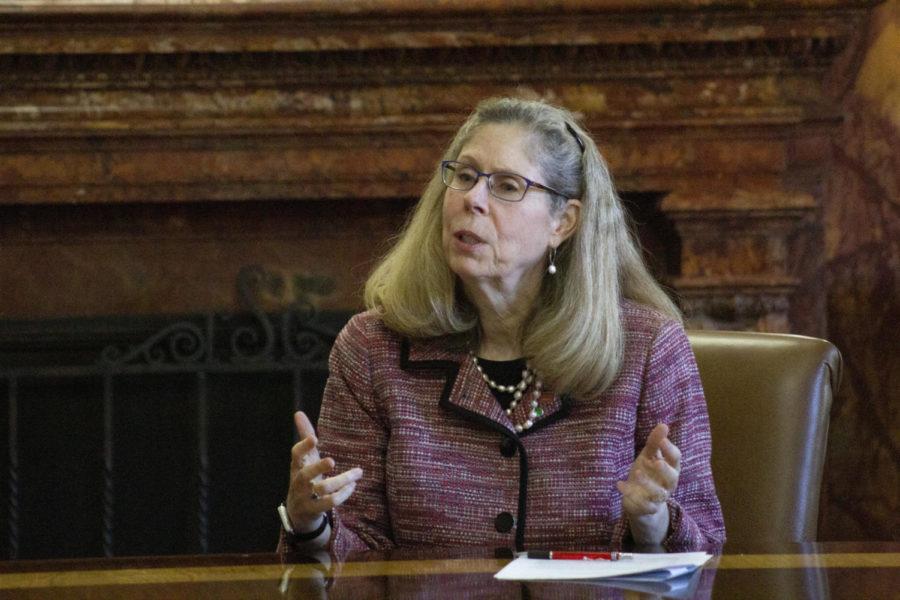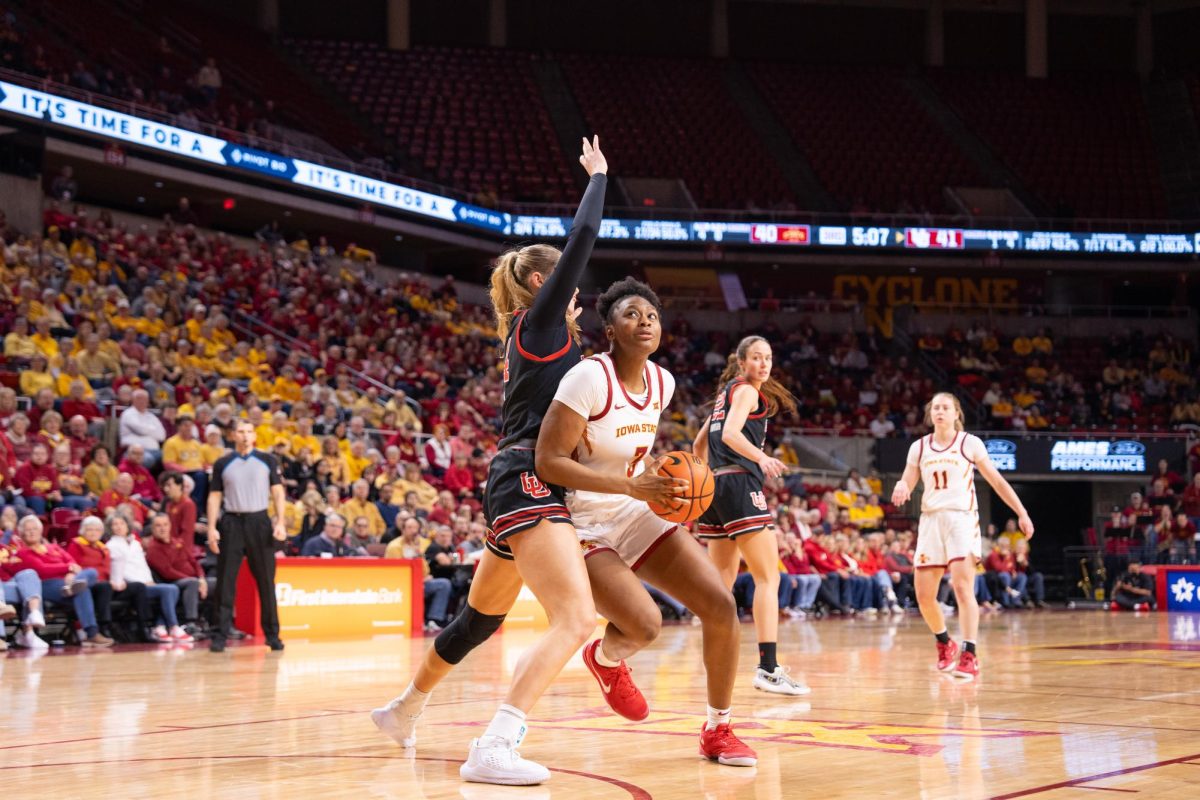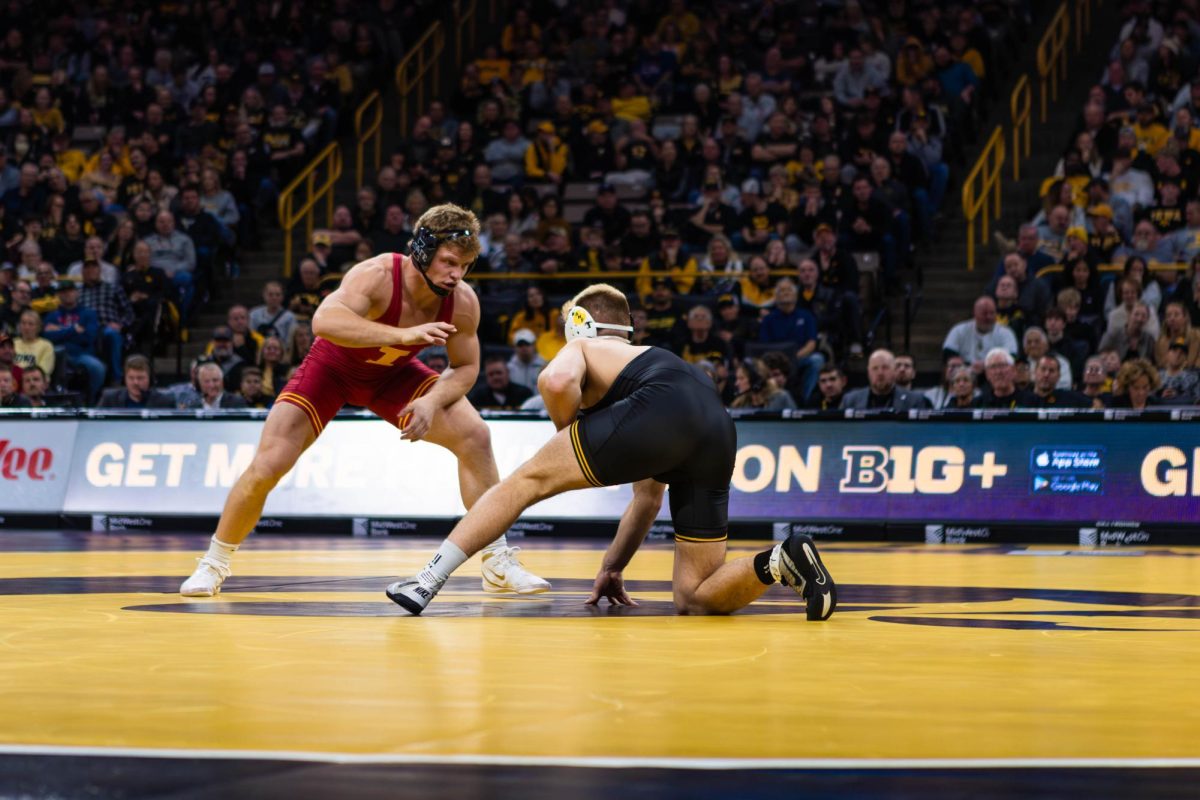Q&A: President Wendy Wintersteen talks tuition, campus safety
January 15, 2019
Iowa State Daily editors sat down with Iowa State President Wendy Wintersteen on Wednesday, Jan. 9 to discuss her administrative priorities, campus initiatives and tuition. This interview has been edited for clarity.
You’ve been at Iowa State for the majority of your career, meaning you probably know a lot about the institution. Is there anything this past year that you have learned that has surprised you?
For me, it’s been a year of listening, hearing what students, faculty and staff have to share with me and what community members around the state have to share as well. So, I think listening will always be a part of what I do as president because I learn so much. When I ask students about their experience, or I ask community members around the state, ‘What would they like to see Iowa State University be leading on, be involved in?’
There has been two dean searches this semester (College of Agriculture and Life Sciences and the College of Engineering), what has your involvement in these processes been like?
We go through a very prescribed search process for these positions, for all positions at Iowa State and the provost is the individual who deans report to, so he leads that process in terms of a search committee and working with the candidates when they do the airport interviews and when they come and do interviews on campus and then he keeps me informed every step of the way, so we talk about who has applied for the position, we talk about what the committee’s recommendations are in terms of bringing individuals to an airport interview, so I am very well briefed and have an opportunity to discuss with the provost, and provide my input to the process.
This semester, graduate students have expressed concerns regarding child care. What is the university currently doing to address this issue?
Child care is an important issue and not just for students but also for faculty and staff. We have issues related to access, issues related to costs that are really very significant and unfortunately it’s not just an Iowa State issue, it’s an Ames, Iowa issue, it’s a Story County issue. Really, it’s an issue throughout Iowa and probably the nation. So, what are we needing to be doing differently? So, we’re going to be looking at what other universities are doing. What are businesses and the industry doing to address this issue? We’re going to have many conversations about child care and try to figure out how we can make a difference. This is a priority and it is clearly one that we saw in the climate survey.
Okta is slowly being implemented across the university, how do you believe that faculty and staff have adapted to the change and what are you hopeful for once it begins to be fully implemented among students?
I think we’re making good progress. It’s been a big job and it’s really impacted everybody’s lives on campus. But, we’re going to get it done. Kristen Constant, who is our interim CIO and vice president, she shared the story one day about back in the ‘70s at Iowa State University, we were the first institution in Iowa that had a computer automatic payroll system and that was because of our great computer science department. Unfortunately, while we did that and a few other things, then we never improved them. So we’re putting in a new set of enterprise management systems that are going to replace systems from the early ‘70s. It’s a critical need and we’re going to get it done. It is a huge effort.
Student leaders have been vocal this semester about how the updated trademark policy has impacted them, can you give any insight on how students and student organizations benefit from this policy alongside the university?
The changes to the trademark policy, as it relates to our student clubs, was something that we had talked about with the past president and vice president of the Student Government. We are now communicating a lot with students about their concerns. When you do a comparison of what a logo would have looked like under the old rule versus what they look like under the new rules, they look pretty good. I think the students are still able to achieve what they want to achieve, in terms of having the right logo. I think those conversations have gone very well. Students who have come in, worked with the Trademark Office, have been able to find, I think, a resolution to their concerns and still achieve the kind of recognition they wanted to have.
How important is it to your administration to hear (and act upon) the concerns of the students — both in a proactive and reactive manner?
It’s very important. If you don’t listen to the students, if you don’t listen to or hear the student experience, then how can you continuously improve? I am very interested in listening to students, I want to hear what their experience has been, and I want to hear what they are concerned about for the future.
At the November Board of Regents meeting, it was outlined students may be facing three different tuition scenarios in the fall [semester], each involving an increase at some level. What was the thinking behind those different levels and how do you feel these options differ from previous years?
So the Board of Regents, as they sent out a tuition proposal for the governor, they wanted the state legislature and the governor to understand that to have the quality education that is provided at the regent universities, that there has to be an appropriate investment and that they also realized that the governor and state Legislature do care about the high cost of education and so they wanted to combine the two issues of tuition and state investment so that the governor and the legislature could have the opportunity to say that we can keep the tuition raises lower if the state made a greater investment. And so that was really the rationale, and not to finalize tuition until after the legislature had made their decision so that the legislature could see that it really is a partnership, it really is an opportunity to work with the Board of Regents on how we can best serve our students.
Would you describe that as an effective middle ground between the legislature and the Board of Regents?
I hope that this new strategy will find that middle ground that will allow the legislature to see that there has to be the investment to maintain the quality and that it probably needs to come from the state and some increased costs from students, as well. So hopefully they’ll see that and be able to respond in a very supportive way. One of my messages this year as I’ve been out and about in the state is that support for Iowa State University from the governor and the legislature is an investment. It’s not a cost. And then, trying to have that mindset be a little different than in the past, that here’s the investment you’re making and here’s the return on investment that you receive in terms of graduates, many who stay in the state or come back at some point, but all who contribute to society and to what the United States can accomplish.
You spoke about the four different [campus climate] working groups that are working on recommendations. Will those recommendations be made public when they are finalized?
Yes, definitely. And there’ll be a set of recommendations and we’ll have to prioritize them, what can we afford to do, which are the highest priority, back to the conversation on childcare, that is a big issue that has a big associated financial cost. So what would be possible and what would some of these priorities be? Areas that we put on as additional items to develop a strategy for. So, it’ll be, yeah, we’ll have great transparency on those and we will have a process of prioritization because in the end, everything costs money.
Green Dot was something that was implemented, which is somewhat of a reactive sort of bystander intervention program. Can students, faculty and staff expect more proactive education on things like consent and sexual harassment? Or, is the university still working with the mindset of “It’s going to happen, so here’s how we try to react to it?”
I believe we always want to take the attitude that prevention is the best cure. Even the Green Dot program begins with training and we’ve had over 2,000 students and staff and faculty participate in the Green Dot training, so even that has a proactive aspect to it. And then, our Title IX training, I don’t know if [The Daily] looked at that, but it is comprehensive, it as an educational module. It is not a short ‘take a look at this in 10 or 15 minutes.’ This is, you’re talking about hours, you’re sitting there and you’re doing an interactive, engaged experience on these issues of sexual harassment and sexual assault. So I think we want to take preventive approach and help everybody understand what they can do. What is it that they can do themselves and how can they help others.
This fall, you successfully reached the fundraising goal for Forever True, for Iowa State — what led to meeting the goal in advance and why the decision to expand donations?
The ISU Foundation, which is the fundraising arm for Iowa State University just had an incredibly successful number of years in terms of raising funds to support our students, faculty and staff. We had two very significant gifts last year — the College of Liberal Arts and Sciences received a gift that was valued at $160 million… that was, I’m sure, the largest gift the college has ever received and is allowing them to do some very special programs. And then we received the gift to name the Ivy College of Business… a $50 million gift, so those gifts really contributed. There’s a tremendous amount of support out there.
When we thought about whether we should stop the campaign or should we continue it, we had lots of conversations with the ISU Foundation board of directors, with individuals, with the deans… and one thing that resonated is that folks love Forever True, For Iowa State campaign slogan and people didn’t want to give it up. It really speaks to what people feel about Iowa State. So, the decision was made that we could be successful in increasing the goal to $1.5 billion, keep the great slogan and continue to help our students, faculty and staff.
The Healthy Life Center, of which Iowa State is a collaborator of, is currently in the works. However, there has been some criticism that it may not be beneficial to students. How does this project align with the university and what do you think it will be able to offer that Iowa State can’t?
It’s a different set of opportunities for the community to reach out and be supportive of a whole set of individuals in the Ames community and Story County. It’ll be interesting, they are still in the process of fundraising for that and they have a ways to go still. So, we’ll see how that turns out. But certainly, given our interest of making sure that we take care of everybody at Iowa State, not just our students, but our faculty and staff and we care deeply about our placement in the community, we certainly are supportive of the project.







